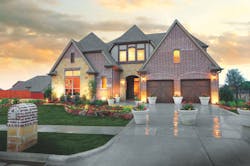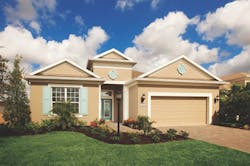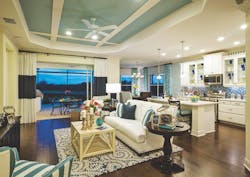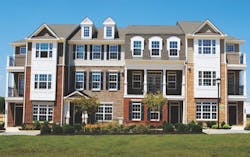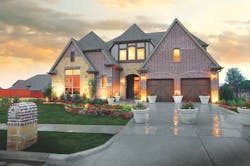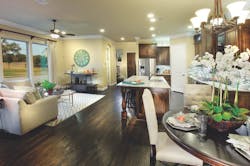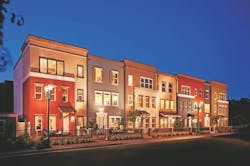Neal Communities
The paucity of younger people in the market for a new home has not deterred Neal Communities. Baby Boomers between the ages of 55 and 65 comprise nearly 80 percent of the Sarasota, Fla.-based builder’s current customer base, with 60 percent of sales specifically to OPALS (older people with active lifestyles), 20 percent to empty nesters (people older than 45 who are employed but without children at home), 10 percent to singles (primarily women), and 10 percent to families, says president Pat Neal.
From 2007 to 2011 the company continually retooled house plans so that its homes became much more cost effective to build. An emphasis on the efficiencies of building shape led to a redesign of the plumbing, air conditioning, and electrical systems, for example, and influenced the choice of value-centric materials as well as the compression of building time. In the last 14 months, however, Neal Communities has found growing interest in its larger homes with the inclusion of new luxury features and more personalization for what the builder calls the “first Florida home” niche market.
Neal Communities sells new homes from $161,990 (for 1,079 square feet) to around $600,000 (for a family home of about 3,400 square feet), whereas Neal Signature Homes builds semi-custom and custom houses from 2,800 square feet to 5,000 square feet for $600,000 to $2 million. The company implemented numerous ideas to reduce the cost of its homes and turn them around faster, including a wholly electronic building platform; the selection of better trade partners plus scaling down the total number of trade partners; the simplification of the land development process and of house plans and specifications; and a cutback in the number of changes allowed for the builder’s non-custom homes.
“We will continue to pursue reduction of time and reduction of unnecessary specifications to have an even more lean building operation,” says Neal, who credits a culture of high performance and an emphasis on quality and finish for the company’s competitive edge.
Neal Communities purchased 13 parcels of land in 2013 and bought 4 parcels so far this year. About 80 percent are broken parcels (approved or partially approved properties before the crunch) while the rest are large parcels (1,000 acres or more) that have been acquired for long-term entitlement and development. The builder will open seven new communities during the remainder of this year and into 2015—growth fueled in part by an increase in model homes (about 50) from the beginning of 2013 to more than 85 projected for 2015.
Eagle Construction
Buyers today tend to be more cautious and require more proof of value, but they still purchase new homes based largely on emotional factors and justify on facts, says Jeff Kornblau, vice president and COO of Eagle Construction. In response to this behavior, the Glen Allen, Va.-based builder adapted its business style to “think like a consumer” and “act like a retailer,” in that the company aims to capture design trends yet offer enough flexibility so buyers can personalize their new homes.
“We actively maintain a wide variety of home plans that are suitable for a variety of different homebuyers,” says Kornblau, who attributes 43 percent of the builder’s sales to active-adult/retirement/empty-nester communities, 37 percent to second move-up buyers and beyond, and 20 percent to first move-up. Eagle constructs attached houses with 1,204 to 3,144 square feet and priced from the low $200,000s to the low $700,000s as well as detached homes with 2,220 to 4,991 square feet and priced from the low $320,000s to the high $900,000s.
The builder introduced myriad design features in the last 12 months to satisfy ongoing customer demand, including outdoor entertainment areas with lanais, kitchens, oversized patios, and screened porches; multigenerational designs with first-floor in-law suites; basements with plenty of well-integrated entertainment space; and Craftsman-style front elevations that offer more character than a traditional elevation. “Product development continues to lead the way for our company,” says Kornblau, who also offers pocket offices, more storage, expandable family rooms, kitchens with oversized islands, and luxury master bathrooms with Roman showers.
Eagle also instituted a number of BIM standards and Lean building practices and converted its house plans from AutoCAD software to Revit, a more sophisticated 3D modeling program. “It will allow us to build our homes more efficiently along with providing certain detail upfront to make design decisions prior to start of construction,” Kornblau says. The tech upgrades continued with the integration of a new customer relationship management (CRM) tool, but establishing a trade partner council ultimately could make the most difference in the company’s initiative to control its production systems and improve communication with subcontractors by providing more accurate information to field personnel and managing current projects more effectively.
Despite a slow start to the year, Eagle remains poised to create future opportunities through expansion. The company, which was sold to the Markel Corporation in 2013, is opening a new division in Williamsburg and will increase its footprint in the Hampton Roads area.
CB JENI
After founding CB JENI Homes in 2009, president Bruno Pasquinelli and his team identified distressed bank assets and undervalued land positions whose owners would subordinate lots. This arrangement helped the Plano, Texas-based builder secure its initial financing, but finding bank money to grow organically proved nearly impossible. In 2010 Pasquinelli partnered with Jim Brickman, a fund manager and adviser, who has provided CB JENI with enough financing and developed lots through JBGL Funds to expand the builder’s business throughout Dallas and surrounding suburbs.
“He recognized the opportunities available to the building companies with capital at the bottom of the [housing] cycle,” says Pasquinelli, who grew up in a Chicago home building company and managed its Dallas/Forth Worth division before founding CB JENI. “The builders that don’t have capital today are getting pushed away from the food bowl.”
The affiliation between CB JENI and JBGL afforded Pasquinelli the ability to launch a second brand—Normandy Homes—and offer a premium product to buyers who want more options and better quality than a mainstream production builder typically can provide. Normandy constructs detached houses of 2,100 to 4,500 square feet at price points from the high $200,000s to $700,000, whereas CB JENI Lifestyle Homes, which targets buyers who desire low-maintenance living, builds attached townhomes ranging from 1,400 to 2,400 square feet and priced from the $180,000s to the $300,000s.
The growing labor shortage contributed to a longer building cycle in 2013 and made managing costs even more of a challenge for CB JENI. The company has focused on recruiting subcontractors, but holding them responsible for their performance becomes onerous because they will simply go to work for a less “demanding” builder. Pasquinelli admits finding the “sweet spot” of accountability and reasonable expectations for trades remains a work in progress, but he says CB JENI adjusted its “touch points” with customers to keep them informed and set the proper expectations for an increasingly unpredictable building process.
The relative uncertainty in the market has rendered 2014 as a transition year for CB JENI, which will construct about the same number of townhomes and detached single-family houses as the company produced in 2013. In the very beginning of their journey, Pasquinelli and his key associates concerned themselves with spreading the builder’s footprint and taking advantage of opportunities in a downtrodden business climate, but today the company strives for operational efficiency to reduce cost and increase profit margins while the market recovers.
The Olson Company
At the end of 2009, the Olson Company researched where job growth likely would occur in Southern California and decided to focus on three core geographical areas: north Orange County, San Gabriel Valley, and the South Bay portion of Los Angeles County that wraps around LAX. The Seal Beach-based builder previously constructed homes throughout California but concluded the company could operate stronger and more efficiently by taking advantage of the opportunities within a 40-mile radius of its corporate headquarters.
“This isn’t the same type of opportunity you’d find in the outlying areas because everything’s been pretty much built on; and what hasn’t been built on, there’s a reason for that,” says CEO Scott Laurie. Olson ranked more than 130 cities and areas in California and ultimately identified the three aforementioned markets as the most attractive based on job growth as well as favorable income levels, school scores, and crime and delinquency rates. “We’ve managed to build in 33 of those cities and areas since 2010,” Laurie says. “Today we have 28 that are in various forms of entitlement, development, and construction.”
Olson aggressively bought land in 2011 after running positive market forecasts while most other builders remained on the sidelines as the industry slowly stabilized. The company began reaping profits from those ventures last year and takes pride in providing solutions for cities and land sellers by making the most out of what could be perceived as challenging land issues. All of the builder’s projects start as entitlements that often involve a rezoning or an environmental cleanup as well as demolition to remove existing structures, says Laurie, who credits past collaboration with state redevelopment agencies as valuable experience for this type of work.
Olson recently closed a project in Fountain Valley in which the builder converted a 130,000-square-foot office building with 6-acre surface parking lot into 88 townhomes and small-lot detached product. The company also has transformed a boat-painting facility in Los Alamitos into 17 small-lot detached homes and is working currently in Temple City to erect 74 paired and detached houses from the site of an old wood-treatment facility and processing plant. “There’s never a discount [on the land] because there’s always an alternative use,” Laurie says. “But we create the value for the upside through the entitlement.”
The builder expects to take in nearly $115 million for 2014 on a minimal unit increase—about 215 closings compared with 188 in 2013. Because it usually takes around two years to turn a project from due diligence to vertical construction, though, Olson anticipates “real” growth in 2015 when the company projects almost 300 closings. PB
Sign-up for Pro Builder Newsletters
Get all of the latest news and updates.
